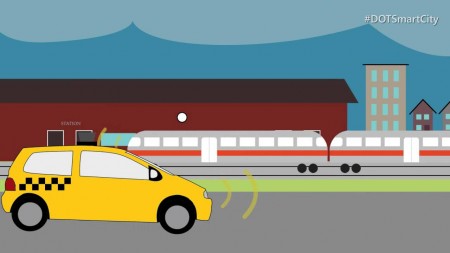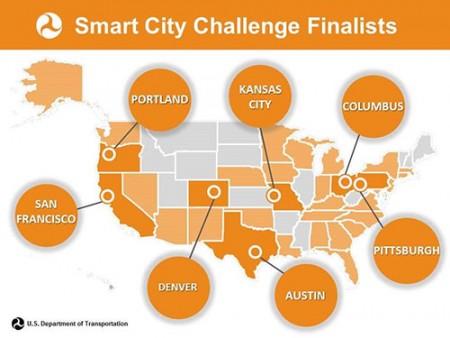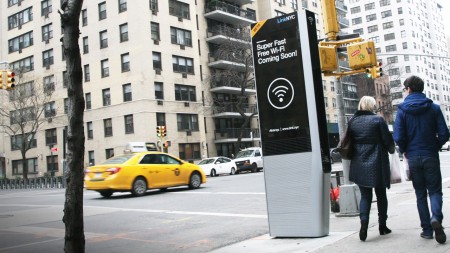March 19, 2016 – Today is Earth Hour when we acknowledge our wasteful energy ways by dimming the lights at dusk for one hour from 8:30 to 9:30 p.m. Over the years it has become a bit of background noise in the cacophony of climate change. But it at least makes an individual feel like he or she can contribute something personal to reduce energy usage and the greenhouse gas emissions created to produce that energy.
Of course the much larger challenge of climate change and greenhouse gas emissions is one needing many planks in a platform for which 21st century transportation represents just one. And that is the subject of today’s posting.
To address transportation for the 21st century back in December 2015 the U.S. Department of Transportation (DOT) launched the Smart City Challenge. Stated Secretary of Transportation Anthony Foxx at the time, “Our national vision is still very much constrained by 20th century thinking about the integration of technology.”
Creating the Challenge to break out of this old way of thinking, DOT asked for submissions from cities with populations between 200,000 and 850,000 by February 4, 2016. The submissions were to address ways to facilitate improvements to transportation including solutions to gridlock, use of autonomous vehicles and vehicle-to-vehicle communication. In a 55 second video posted to YouTube, DOT described the Smart City as one “where transportation just works. Gridlock is a thing of the past. Lights turn green as you approach. Traffic flows smoothly as your car talks to other cars to avoid crashes. It even talks to pedestrians and bicycles. Your driverless taxi shows up just as your train pulls into the station. You arrive home from work and your automated grocery list is delivered just in time for dinner, from the farm to your table.”
The winning city is to receive $40 million from DOT and an additional $10 million from to companies, Paul Allen’s Vulcan Inc., and Rick Clemmer’s NXP Semiconductors. In the last week at the South by Southwest conference in Austin, Texas, seven finalists were announced from 77 city submissions supported by 300 different companies. The cities still competing for the $50 million appear on the map seen below:
In announcing the contest, Foxx had stated, “The 21st century will be dominated by urbanization…The entire world is….having a conversation about smart cities and what they should look like.”
Each finalist is to receive $100,000 to help put its final proposal together with the winner to be announced in June of this year. Although aimed at mid-sized American cities it is believed that all urban centres, both large and small, will benefit from the range of solutions that get presented.
Alphabet (the name of the new Google) has a subsidiary, Sidewalk Labs. The company, launched in June 2015, is building an integrated platform that combines an understanding of big data, technology, and best practices looking at urban transportation, social services, health and public safety. One of its products is FLOW, a transportation coordination platform.
FLOW is an open platform (capable of working with multiple data sources and software interfaces) that uses analytics (a systematic analysis of huge amounts of data by computers) to look at road use, infrastructure, and policy. The data, both structured and unstructured, includes information gleaned from mobile communications, sensors, cameras and other digital sources to create a real-time transportation picture.
FLOW analyzes selective road segments to better understand neighbourhoods and traffic flow.
FLOW simulates how changes to urban transportation impacts these flows.
FLOW allows smart city planners to deploy and test new technologies to determine overall system impact.
FLOW can route drivers to parking spaces and provide through mobile apps directions, pricing, and availability at the beginning and throughout a drive. It can enable and optimize the use of curb space to help logistics companies to deliver vital goods and services to city businesses.
FLOW can adjust transit routes and time in real-time advising would be and existing riders through their mobile phones.
FLOW can minimize conflicts between automobiles, bicycles and pedestrians by keeping all of them informed about changing surface conditions.
FLOW is the DOT proffered tool that will be given at no cost to the winning city in the Smart City Challenge. In addition Sidewalk is giving the winner its on-street Link kiosks. These kiosks (see illustration below) are being installed today in New York City under the city’s PlanNYC program. Designed to replace 6,500 antiquated public pay phones with a network of 7,500 data communication hubs, each Link features free Gigabit Wi-FI, video and voice calling, and access to emergency and other city services.
The revenue model for LinkNYC is designed around a 50/50 split between the city and the company and mobile system providers. New York City estimates its share of the income over 12 years at $500 million. So not only will the winning city get $50 million to help implement 21st century transportation solutions, it will also gain a new source of ongoing revenue. Now that’s a Smart City.

















